Urban Renewal Potential of Old Urban Areas in Resource-Based Cities in Developing Countries: A Case Study of Dongsheng District, Ordos, China
Abstract
:1. Introduction
2. Literature Review
3. Materials and Methods
3.1. Study Area
3.2. Research Framework
3.3. Urban Renewal Potential Assessment System
3.4. Comparative Analysis of Urban Renewal Potential Based on Current Land Use and Historical Development
3.5. Data and Materials
4. Results
4.1. Results of Urban Renewal Potential Assessment System
4.1.1. Land Development Status
4.1.2. Architectural and Spatial Environmental Quality
4.1.3. Coordination Difficulty in Renewal and Redevelopment
4.1.4. Overall Assessment of Urban Renewal Potential
4.2. Results of Comparative Analysis
4.2.1. Comparative Analysis Based on Current Land Use
4.2.2. Comparative Analysis Based on Historical Development
5. Discussion and Strategies
5.1. Potential Spatial Distribution Patterns
5.1.1. Discussion of Indicator-Level Results
5.1.2. Discussion of the Overall Results
5.2. Contributions of This Research
5.3. Limitations and Future Research Suggestions
6. Conclusions
Author Contributions
Funding
Data Availability Statement
Conflicts of Interest
Appendix A
| Dimension Level | Factor Level | Indicator Level | |||||||
|---|---|---|---|---|---|---|---|---|---|
| Dimension Weight | Factor Weight | Indicator | Assessment Criteria | Score Division | Indicator Weight | ||||
| Land usedevelopment status | 0.3 | Land base value | 0.1 | Road Connectivity | Buffer score | 2.0–3.0 | 5 | 0.04 | |
| 1.0–2.0 | 3 | ||||||||
| 0.0–1.0 | 1 | ||||||||
| Population Aggregation | population/ha | 130–190 | 5 | 0.03 | |||||
| 90–130 | 4 | ||||||||
| 50–90 | 3 | ||||||||
| 30–50 | 2 | ||||||||
| 0–30 | 1 | ||||||||
| Landscape Environment | Buffer score | 2.0–3.0 | 5 | 0.03 | |||||
| 1.0–2.0 | 3 | ||||||||
| 0.0–1.0 | 1 | ||||||||
| land development intensity | 0.2 | Floor Area Ratio | Floor Area Ratio | 0.0–1.0 | 5 | 0.12 | |||
| 1.0–2.0 | 4 | ||||||||
| 2.0–3.5 | 3 | ||||||||
| 3.5–5 | 2 | ||||||||
| >5.0 | 1 | ||||||||
| Building Density | Building Density | 0.4–0.6 | 5 | 0.08 | |||||
| 0.6–0.8 | 4 | ||||||||
| 0.8–1.0 | 3 | ||||||||
| 0.2–0.4 | 2 | ||||||||
| 0.0–0.2 | 1 | ||||||||
| Architectural and Spatial Environment | 0.5 | Construction Status Potential | 0.15 | Building Function | Building Function | First grade | 5 | 0.045 | |
| Second order | 3 | ||||||||
| Third estate | 1 | ||||||||
| Building Height | Maximum number of building floors | 0.0–5.0 | 5 | 0.06 | |||||
| 5.0–10.0 | 4 | ||||||||
| 10.0–15.0 | 3 | ||||||||
| 15.0–20.0 | 2 | ||||||||
| 20.0–25.0 | 1 | ||||||||
| Building Quality | Average value of building quality | 0.0–0.6 | 5 | 0.045 | |||||
| 0.6–1.2 | 4 | ||||||||
| 1.2–1.8 | 3 | ||||||||
| 1.8–2.4 | 2 | ||||||||
| 2.4–3.0 | 1 | ||||||||
| Facility Provision Potential | 0.35 | Educational Facilities Provision | Buffer score | 4.0–5.0 | 5 | 0.105 | |||
| 3.0–4.0 | 4 | ||||||||
| 2.0–3.0 | 3 | ||||||||
| 1.0–2.0 | 2 | ||||||||
| 0.0–1.0 | 1 | ||||||||
| Medical Facilities | Buffer score | 2.0–3.0 | 5 | 0.07 | |||||
| 1.0–2.0 | 3 | ||||||||
| 0.0–1.0 | 1 | ||||||||
| Elderly Care Facilities | Buffer score | 2.0–3.0 | 5 | 0.0525 | |||||
| 1.0–2.0 | 3 | ||||||||
| 0.0–1.0 | 1 | ||||||||
| Commercial Facilities | Buffer score | 2.0–3.0 | 5 | 0.0525 | |||||
| 1.0–2.0 | 3 | ||||||||
| 0.0–1.0 | 1 | ||||||||
| Park and Green Space | Buffer score | 2.0–3.0 | 5 | 0.035 | |||||
| 1.0–2.0 | 3 | ||||||||
| 0.0–1.0 | 1 | ||||||||
| Sports Facilities | Buffer score | 2.0–3.0 | 5 | 0.035 | |||||
| 1.0–2.0 | 3 | ||||||||
| 0.0–1.0 | 1 | ||||||||
| Coordination Difficulty in Renewal and | 0.2 | Property Rights Complexity Potential | 0.1 | Property Rights Complexity | Property Rights | single ownership | 5 | 0.1 | |
| two major kinds of ownership | 3 | ||||||||
| multiple ownerships | 1 | ||||||||
| Willingness to Urban Renewal Potential | 0.1 | Willingness to Urban renewal | Willingness to Urban renewal | 4.0–5.0 | 5 | 0.1 | |||
| 3.0–4.0 | 4 | ||||||||
| 2.0–3.0 | 3 | ||||||||
| 1.0–2.0 | 2 | ||||||||
| 0.0–1.0 | 1 | ||||||||
| Summation | 1 | 1 | 1 | ||||||
- Road Connectivity
- Population Agglomeration
- Landscape Environment
- Floor Area Ratio
- Building Density
- Building Function
- Building Height
- Building Quality
- Educational Facilities
- Medical Facilities
- Elderly Care Facilities
- Commercial Facilities
- Parks and Green Spaces
- Sports Facilities
- Ownership Complexity
- Willingness to Urban renewal
- Overall Assessment of Urban Renewal Potential
Appendix B
| Serial Number | Description | Assessment Scale | Descriptive Statistics | |
|---|---|---|---|---|
| Number | Scale (%) | |||
| 1 | What is your domicile? | A. Dongsheng District | 193 | 59.38% |
| B. Surrounding towns in Dongsheng District | 19 | 5.85% | ||
| C. Flags of other districts outside Dongsheng District, Ordos City | 60 | 18.46% | ||
| D. Other cities | 53 | 16.31% | ||
| This topic is valid to fill in the number of people | 325 | 100.00% | ||
| 2 | What is your residential address? | A. Dongsheng District | 310 | 95.38% |
| B. Surrounding towns in Dongsheng District | 7 | 2.15% | ||
| C. Flags of other districts outside Dongsheng District, Ordos City | 8 | 2.46% | ||
| D. Other cities | 0 | 0.00% | ||
| This topic is valid to fill in the number of people | 325 | 100.00% | ||
| 3 | How long have you lived (worked) in Dongsheng? | A. Within six months | 5 | 1.54% |
| B. Six months to one year | 3 | 0.92% | ||
| C. 1 to 3 years | 12 | 3.69% | ||
| D. 3 years to 3 years | 13 | 4.00% | ||
| E. More than 5 years | 292 | 89.85% | ||
| This topic is valid to fill in the number of people | 325 | 100.00% | ||
| 4 | What is your monthly income? | A. Less than 5000 | 133 | 40.92% |
| B. 5000–8000 | 125 | 38.46% | ||
| C. 8000–12,000 | 41 | 12.62% | ||
| D. 12,000–15,000 | 8 | 2.46% | ||
| E. More than 15,000 | 18 | 5.54% | ||
| This topic is valid to fill in the number of people | 325 | 100.00% | ||
| 5 | What is your occupation? | A. Public officials (employees of state-owned enterprises and institutions) | 113 | 34.77% |
| B. Employees of private and foreign companies | 66 | 20.31% | ||
| C. Self-employed households | 26 | 8.00% | ||
| D. Freelance work | 36 | 11.08% | ||
| E. Students | 5 | 1.54% | ||
| F. Agricultural personnel | 6 | 1.85% | ||
| G. Retirees | 11 | 3.38% | ||
| I. Other | 62 | 19.08% | ||
| This topic is valid to fill in the number of people | 325 | 100.00% | ||
| 6 | Where do you work/study? | A. Suburbs near Ring Road, Dongsheng District | 54 | 16.62% |
| B. Industrial plant area in Dongsheng City | 14 | 4.31% | ||
| C. Old business districts/old office buildings in or around Dongsheng City (built before 2005) | 51 | 15.69% | ||
| D. Newly built commercial office buildings in or around Dongsheng City in recent years (built after 2005) | 102 | 31.38% | ||
| E. Kangbashi New District | 25 | 7.69% | ||
| F. Other | 79 | 24.31% | ||
| This topic is valid to fill in the number of people | 325 | 100.00% | ||
| 7 | Which of the following houses do you live in? | A. New residential area (after 2005) | 234 | 72.00% |
| B. Old residential areas (before 2005) | 70 | 21.54% | ||
| C. Urban villages | 9 | 2.77% | ||
| D. Village on the edge of town | 12 | 3.69% | ||
| This topic is valid to fill in the number of people | 325 | 100.00% | ||
| 8 | What type of house do you live in? | A. Purchase commercial housing | 248 | 76.31% |
| B. Rent | 20 | 6.15% | ||
| C. Staff quarters | 8 | 2.46% | ||
| D. Individual house building | 10 | 3.08% | ||
| E. Has purchased the unit public housing | 5 | 1.54% | ||
| F. Housing placement | 21 | 6.46% | ||
| G. Affordable housing | 2 | 0.62% | ||
| H. Other | 11 | 3.38% | ||
| This topic is valid to fill in the number of people | 325 | 100.00% | ||
| 9 | What do you think of the living environment in Dongsheng District? | A. Very satisfied | 45 | 13.85% |
| B. Satisfied | 156 | 48.00% | ||
| C. General | 99 | 30.46% | ||
| D. Not satisfied | 17 | 5.23% | ||
| E. Very dissatisfied | 8 | 2.46% | ||
| This topic is valid to fill in the number of people | 325 | 100.00% | ||
| 10 | Do you think the urban space of Dongsheng Old Town has characteristics | A. Distinctive. If so, which area do you think best represents the urban character of the Old City is _______________ | 61 | 18.77% |
| B. In general | 195 | 60.00% | ||
| C. No features | 69 | 21.23% | ||
| This topic is valid to fill in the number of people | 325 | 100.00% | ||
| 11 | If the Dongsheng District is updated, which of the following categories do you think should be updated first? | A. Shanty towns | 175 | 53.85% |
| B. Old residential area | 179 | 55.08% | ||
| C. Old factory, factory building | 44 | 13.54% | ||
| D. Old business district | 75 | 23.08% | ||
| E. Park green space | 112 | 34.46% | ||
| F. Streets with poor features | 158 | 48.62% | ||
| G. Other | 24 | 7.38% | ||
| This topic is valid to fill in the number of people | 325 | 100.00% | ||
| 12 | Which renewal method do you prefer for the old factories and factories in the city? | A. Continue to maintain production and improve the environment | 54 | 16.62% |
| B. After relocation, the factory buildings will be completely demolished and converted to other uses | 165 | 50.77% | ||
| C. After relocation, the factory building will be retained as an urban memory and converted to other purposes after renovation | 106 | 32.62% | ||
| This topic is valid to fill in the number of people | 325 | 100.00% | ||
| 13 | What kind of renewal do you prefer for old business districts in urban areas? | A. The building is too old and does not conform to commercial fashion trends, and needs to be completely rebuilt | 87 | 26.77% |
| B. The building quality is reasonable, but the lack of design sense, daily use is not convenient, do local reconstruction and upgrading can be done | 133 | 40.92% | ||
| C. The business of Dongsheng District is sufficient, and it should be demolished and rebuilt into other service facilities such as green park | 105 | 32.31% | ||
| This topic is valid to fill in the number of people | 325 | 100.00% | ||
| 14 | What do you think is the most important aspect of park green space that needs to be updated? | A. The exercise area is small | 167 | 51.38% |
| B. Inadequate sports and exercise facilities | 163 | 50.15% | ||
| C. Leisure facilities such as pavilions and seats are insufficient | 115 | 35.38% | ||
| D. Not enough green vegetation | 100 | 30.77% | ||
| E. Low distribution density, too far away from the working and living places | 140 | 43.08% | ||
| F. The need to strengthen ties with the bustling business district | 93 | 28.62% | ||
| G. Need to enhance the cultural connotation of park green space | 152 | 46.77% | ||
| This topic is valid to fill in the number of people | 325 | 100.00% | ||
| 15 | In terms of streetscape, what do you think needs to be improved? | A. Urban landscape lighting | 106 | 32.62% |
| B. Street greening | 150 | 46.15% | ||
| C. Building exterior wall decoration | 103 | 31.69% | ||
| D. City billboards | 48 | 14.77% | ||
| E. Wall/fence style | 74 | 22.77% | ||
| F. Road View slow walking trail | 189 | 58.15% | ||
| G. River landscape | 135 | 41.54% | ||
| H. Street building facade | 101 | 31.08% | ||
| This topic is valid to fill in the number of people | 325 | 100.00% | ||
| 16 | What area do you live in? | A. Traffic streets | 15 | 4.62% |
| B. Park Street | 19 | 5.85% | ||
| C. Build streets | 18 | 5.54% | ||
| D. Tree-lined streets | 17 | 5.23% | ||
| E. Tianjiao Street | 16 | 4.92% | ||
| F. Revival Street | 12 | 3.69% | ||
| G. Textile streets | 86 | 26.46% | ||
| H. Bayimenke Street | 35 | 10.77% | ||
| I. Joerun Street | 12 | 3.69% | ||
| J. Ethnic Street | 13 | 4.00% | ||
| K. Happy Street | 68 | 20.92% | ||
| L. Xingsheng Street | 14 | 4.31% | ||
| This topic is valid to fill in the number of people | 325 | 100.00% | ||
| 17 | What do you think are the advantages of where you live? | A. Geographical location convenient travel, convenient public transportation | 167 | 51.38% |
| B. Convenient parking with ample parking space | 116 | 35.69% | ||
| C. Mature public service facilities (such as education, culture, medical care, elderly care) and municipal facilities | 64 | 19.69% | ||
| D. Low residential density, clean and orderly living environment, high quality | 85 | 26.15% | ||
| E. Strong cultural atmosphere and rich cultural activities | 23 | 7.08% | ||
| F. Favorable support of policies (hukou policy, talent policy, housing policy, etc.) | 24 | 7.38% | ||
| G. Adequate employment and good economic vitality | 17 | 5.23% | ||
| H. Suitable land price, rent, low cost of living | 105 | 32.31% | ||
| This topic is valid to fill in the number of people | 325 | 100.00% | ||
| 18 | What kind of results do you expect from urban renewal? | A. Improve residents’ living conditions and increase urban employment | 188 | 57.85% |
| B. Control urban traffic congestion | 111 | 34.15% | ||
| C. Provide better public transport | 78 | 24.00% | ||
| D. Improve education, medical care, culture, elderly care and other service facilities | 210 | 64.62% | ||
| E. Improving the service level of commercial service facilities | 75 | 23.08% | ||
| F. Increase the area and accessibility of urban parks and green Spaces | 95 | 29.23% | ||
| G. Strengthen the protection of urban cultural space and urban features | 70 | 21.54% | ||
| H. Dredge the population of the old city and reduce the population density | 52 | 16.00% | ||
| I. Improve the quality of the urban environment, improve and restore the natural landscape environment | 116 | 35.69% | ||
| J. Other | 10 | 3.08% | ||
| This topic is valid to fill in the number of people | 325 | 100.00% | ||
| Topic\Option | 1 | 2 | 3 | 4 | 5 | Average Score |
|---|---|---|---|---|---|---|
| A. Economic and industrial development in the old city | 43 (13.23%) | 33 (10.15%) | 107 (32.92%) | 90 (27.69%) | 52 (16%) | 3.23 |
| B. Urban road traffic smooth degree | 30 (9.23%) | 39 (12%) | 91 (28%) | 96 (29.54%) | 69 (21.23%) | 3.42 |
| C. Urban public transportation convenience | 16 (4.92%) | 36 (11.08%) | 74 (22.77%) | 103 (31.69%) | 96 (29.54%) | 3.7 |
| D. Convenience of daily shopping | 14 (4.31%) | 24 (7.38%) | 72 (22.15%) | 96 (29.54%) | 119 (36.62%) | 3.87 |
| E. Convenience of nearby enrollment for compulsory education | 27 (8.31%) | 33 (10.15%) | 63 (19.38%) | 116 (35.69%) | 86 (26.46%) | 3.62 |
| F. Ease of access to the medical services needed nearby | 26 (8%) | 59 (18.15%) | 94 (28.92%) | 97 (29.85%) | 49 (15.08%) | 3.26 |
| G. Convenience of using social welfare facilities such as elderly care | 52 (16%) | 51 (15.69%) | 104 (32%) | 77 (23.69%) | 41 (12.62%) | 3.01 |
| H. Convenient use of cultural facilities and recreational facilities | 55 (16.92%) | 54 (16.62%) | 104 (32%) | 69 (21.23%) | 43 (13.23%) | 2.97 |
| I. Ease of use of sports facilities | 64 (19.69%) | 72 (22.15%) | 89 (27.38%) | 59 (18.15%) | 41 (12.62%) | 2.82 |
| J. The convenience of using the park green space plaza | 43 (13.23%) | 50 (15.38%) | 73 (22.46%) | 86 (26.46%) | 73 (22.46%) | 3.3 |
| K. Ease of use of water, electricity, gas and other infrastructure | 24 (7.38%) | 32 (9.85%) | 63 (19.38%) | 95 (29.23%) | 111 (34.15%) | 3.73 |
| L. Overall sense of security in residential life | 17 (5.23%) | 15 (4.62%) | 37 (11.38%) | 93 (28.62%) | 163 (50.15%) | 4.14 |
| M. Air, water, soil, and other urban environments | 17 (5.23%) | 26 (8%) | 71 (21.85%) | 117 (36%) | 94 (28.92%) | 3.75 |
| N. City appearance and cleanliness | 14 (4.31%) | 18 (5.54%) | 65 (20%) | 111 (34.15%) | 117 (36%) | 3.92 |
| subtotal | 442 (9.71%) | 542 (11.91%) | 1107 (24.33%) | 1305 (28.68%) | 1154 (25.36%) | 3.48 |
References
- Yu, J.; Li, J.; Zhang, W. Identification and classification of resource-based cities in China. J. Geogr. Sci. 2019, 29, 1300–1314. [Google Scholar] [CrossRef]
- Wang, R.; Wang, C.; Zhang, S.; Ding, X. A study on the spatial and temporal evolution of urban shrinkage and its influencing factors from a multidimensional perspective: A case study of resource-based cities in China. PLoS ONE 2021, 16, e258524. [Google Scholar] [CrossRef]
- Huang, Y.; Fang, Y.; Gu, G.; Liu, J. The evolution and differentiation of economic convergence of resource-based cities in Northeast China. Chin. Geogr. Sci. 2018, 28, 495–504. [Google Scholar] [CrossRef]
- Xue, M.; Zhang, X.; Sun, X.; Sun, T.; Yang, Y. Expansion and Evolution of a Typical Resource-Based Mining City in Transition Using the Google Earth Engine: A Case Study of Datong, China. Remote Sens. 2021, 13, 4045. [Google Scholar] [CrossRef]
- Ye, X.; Dong, L.; Lv, L.; Shang, Y. Spatiotemporal evolution law and driving force of mining city patterns. Environ. Sci. Pollut. Res. 2022, 29, 10291–10307. [Google Scholar] [CrossRef] [PubMed]
- Tao, Y.; Wang, Q. Quantitative Recognition and Characteristic Analysis of Production-Living-Ecological Space Evolution for Five Resource-Based Cities: Zululand, Xuzhou, Lota, Surf Coast and Ruhr. Remote Sens. 2021, 13, 1563. [Google Scholar] [CrossRef]
- Available online: https://investaberdeen.co.uk/key-sectors (accessed on 5 February 2024).
- Thriving Pittsburgh Industries. Available online: https://pittsburghregion.org/key-industries/ (accessed on 5 February 2024).
- Available online: https://www.calgaryeconomicdevelopment.com/sectors/ (accessed on 5 February 2024).
- Available online: https://www.houstontx.gov/abouthouston/business.html (accessed on 5 February 2024).
- The Official Site of the Prime Minister of the Russian Federation. Available online: http://archive.premier.gov.ru/eng/visits/ru/6041/region/print/ (accessed on 6 February 2024).
- Economy of Baku. Available online: https://en.wikipedia.org/wiki/Economy_of_Baku#Light_industry (accessed on 6 February 2024).
- Statistical Bulletin of Daqing City’s National Economic and Social Development in 2022. Available online: https://www.saertu.gov.cn/saertu/zfxxgk351/202311/c05_321431.shtml (accessed on 28 August 2024).
- Chiatura Mining Town. Available online: https://www.ovpm.org/city/chiatura-georgia/ (accessed on 6 February 2024).
- Behind the Difference in Housing Prices between the New and Old Urban Areas of Hebi: The Permanent Population in the Old Urban Area Stopped Flowing out and Showed a Reflux Trend. Available online: https://baijiahao.baidu.com/s?id=1766224026813835558&wfr=spider&for=pc (accessed on 6 February 2024).
- China’s Former First Oil City, Oil Exploitation into an Empty City, from the City to the Town, the House Price Is Less than 1000 yuan. Available online: https://cul.sohu.com/a/725572721_121165105 (accessed on 6 February 2024).
- District Situation Overview. Available online: http://www.kbs.gov.cn/zjkbs/qqgk/ (accessed on 19 October 2023).
- Abandoned Architectural Marvels in China’s Largest Ghost Town. Available online: https://edition.cnn.com/style/article/china-ordos-ghost-town/index.html (accessed on 19 October 2023).
- Ordos “Ghost City” under the Phantom Double Crisis. Available online: https://www.bjnews.com.cn/feature/2013/08/31/281143.html (accessed on 19 October 2023).
- Ordos Is Full of Empty Buildings Citizens: Will Not Buy Again. Available online: http://politics.people.com.cn/n/2014/1128/c70731-26113626.html (accessed on 19 October 2023).
- “Warm City Fanghua” Series Report Three-Ordos City: Accelerate Urban Renewal and Improve Urban Quality. Available online: https://www.ordos.gov.cn/xw_127672/jreeds/202309/t20230904_3481948.html (accessed on 24 October 2023).
- Response of the Ordos City Dongsheng District Comprehensive Urban Management and Administrative Law Enforcement Bureau to Proposal No. 35 at the First Session of the Tenth People’s Congress of Dongsheng District. Available online: https://www.ds.gov.cn/gk/fdzdgknr/jytabl/rdjy/202211/t20221129_3310028.html (accessed on 25 June 2024).
- Analysis of the October 2023 Labor Force Survey Data in Dongsheng District. Available online: https://www.ds.gov.cn/gk/fdzdgknr/tjxx/tjfx/202311/t20231109_3523942.html (accessed on 25 June 2024).
- Ding, F.; Wu, J. The evolution of relevant concepts of urban renewal and its current practical significance. Urban Plan. Forum 2017, 1, 87–95. [Google Scholar] [CrossRef]
- Couch, C.; Sykes, O.; Börstinghaus, W. Thirty years of urban regeneration in Britain, Germany and France: The importance of context and path dependency. Prog. Plan. 2011, 75, 1–52. [Google Scholar] [CrossRef]
- Tallon, A. Urban Regeneration in the UK, 3rd ed.; Routledge: London, UK, 2020; ISBN 9781351030304. [Google Scholar]
- Karadimitriou, N.; de Magalhães, C.; Verhage, R. Planning, Risk and Property Development: Urban Regeneration in England, France and The Netherlands; Routledge: London, UK, 2013; ISBN 978-0415481106. [Google Scholar]
- Wu, Y.; Galdini, R.; Hui, E.C.M.; Long, H. Urban regeneration and re-use: China and Europe. Cities 2020, 106, 102863. [Google Scholar] [CrossRef]
- Della Torre, S.; Cattaneo, S.; Lenzi, C.; Zanelli, A. Regeneration of the Built Environment from a Circular Economy Perspective; Springer Nature: Berlin/Heidelberg, Germany, 2020; pp. 1–13. ISBN 978-3-030-33256-3. [Google Scholar]
- Liu, E.; Wang, Y.; Chen, W.; Chen, W.; Ning, S. Evaluating the transformation of China’s resource-based cities: An integrated sequential weight and TOPSIS approach. Socio-Econ. Plan. Sci. 2021, 77, 101022. [Google Scholar] [CrossRef]
- Zhang, M.; Tan, F.; Lu, Z. Resource-based cities (RBC): A road to sustainability. Int. J. Sustain. Dev. World Ecol. 2014, 21, 465–470. [Google Scholar] [CrossRef]
- Tan, J.; Zhang, P.; Lo, K.; Li, J.; Liu, S. The Urban Transition Performance of Resource-Based Cities in Northeast China. Sustainability 2016, 8, 1022. [Google Scholar] [CrossRef]
- Yu, C.; de Jong, M.; Cheng, B. Getting depleted resource-based cities back on their feet again–the example of Yichun in China. J. Clean. Prod. 2016, 134, 42–50. [Google Scholar] [CrossRef]
- Fan, F.; Zhang, X. Transformation effect of resource-based cities based on PSM-DID model: An empirical analysis from China. Environ. Impact Assess. Rev. 2021, 91, 106648. [Google Scholar] [CrossRef]
- Yang, Y.; Cheng, D.; Zhang, B.; Guan, C.; Cheng, X.; Cheng, T. Coal resource-based cities at the crossroads: Towards a sustainable urban future. Cities 2023, 140, 104424. [Google Scholar] [CrossRef]
- Yang, H.; Zhai, G.; Zhang, Y. Ecological vulnerability assessment and spatial pattern optimization of resource-based cities: A case study of Huaibei City, China. Hum. Ecol. Risk Assess. Int. J. 2021, 27, 606–625. [Google Scholar] [CrossRef]
- Song, W.; Yin, S.; Zhang, Y.; Qi, L.; Yi, X. Spatial-temporal evolution characteristics and drivers of carbon emission intensity of resource-based cities in China. Front. Environ. Sci. 2022, 10, 972563. [Google Scholar] [CrossRef]
- Song, Y.; Yeung, G.; Zhu, D.; Xu, Y.; Zhang, L. Efficiency of urban land use in China’s resource-based cities, 2000–2018. Land Use Policy 2022, 115, 106009. [Google Scholar] [CrossRef]
- Woodworth, M.D. Ordos Municipality: A market-era resource boomtown. Cities 2015, 43, 115–132. [Google Scholar] [CrossRef]
- Yin, D.; Qian, J.; Zhu, H. Living in the “Ghost City”: Media Discourses and the Negotiation of Home in Ordos, Inner Mongolia, China. Sustainability 2017, 9, 2029. [Google Scholar] [CrossRef]
- Yin, D.; Gao, Q.; Yang, M. Reconstruction and negotiation of the “home” of urban landless peasants: A case study of Ordos. Sci. Geogr. Sin. 2019, 12, 2. [Google Scholar] [CrossRef]
- Liu, R.; Chao, L.; Fan, Q. Analysis of coordination between population and economic system in resource-based cities—Taking Ordos City as an example. Areal Res. Dev. 2016, 3, 14. [Google Scholar] [CrossRef]
- Bai, Y.; Wu, S.; Zhang, Y. Exploring the Key Factors Influencing Sustainable Urban Renewal from the Perspective of Multiple Stakeholders. Sustainability 2023, 15, 10596. [Google Scholar] [CrossRef]
- Tang, Y. Analysis of key dimensions and strategies of China’s urban renewal system construction. Urban Plan. Int. 2022, 37, 1. [Google Scholar] [CrossRef]
- Yao, K.; Lu, Y.; Li, X.; Ruan, H.; Gao, F.; Shao, S.; Sun, Y.; Liu, Y.; Li, J. Evaluating and Analyzing Urban Renewal and Transformation Potential Based on AET Models: A Case Study of Shenzhen City. Sustainability 2023, 15, 13528. [Google Scholar] [CrossRef]
- Hemphill, L.; McGreal, S.; Berry, J. An indicator-based approach to measuring sustainable urban regeneration performance: Part 2, empirical evaluation and case-study analysis. Urban Stud. 2004, 41, 757–772. [Google Scholar] [CrossRef]
- Zheng, H.W.; Shen, G.Q.; Song, Y.; Sun, B.; Hong, J. Neighborhood sustainability in urban renewal: An assessment framework. Environ. Plan. B 2017, 44, 903–924. [Google Scholar] [CrossRef]
- Liu, C.; Chen, S.X.; Huang, Z.Y.; Yan, S.X. Evaluation of urban renewal potential supported by multi-source data. World Archit. 2023, 07, 18–19. [Google Scholar] [CrossRef]
- Hu, J.H.; Zhang, J.X. Urban renewal dilemma analysis and governance path based on collective action theory. Urban Dev. Stud. 2022, 29, 22–30. [Google Scholar] [CrossRef]
- Qin, H.L. Bottleneck and Legislative Suggestion of Public Participation in Urban Renewal: A Case Study of Residential Urban Renewal in Beijing. Urban Rural. Dev. 2022, 1, 12–15. [Google Scholar]
- How to “Customize” a 15-Minute Community Life Circle in a Megacity. Available online: https://sghexport.shobserver.com/html/baijiahao/2023/02/08/957993.html (accessed on 8 April 2024).
- Rust Belt in the ‘Golden Coal Triangle’. Available online: https://www.rmzxb.com.cn/c/2014-06-16/339921_3.shtml?n2m=1 (accessed on 6 February 2024).
- Ordos Mayor: There Is Still a Backlog of Nearly 40,000 Housing Units, Which Will Be Absorbed within Three Years. Available online: https://npc.people.com.cn/n/2014/0307/c376899-24567430.html (accessed on 6 February 2024).
- GB50180-93; Code for Urban Residential Area Planning and Design. Ministry of Housing and Urban-Rural Development of the People’s Republic of China & General Administration of Quality Supervision, Inspection and Quarantine of the People’s Republic of China: Beijing, China, 2016.
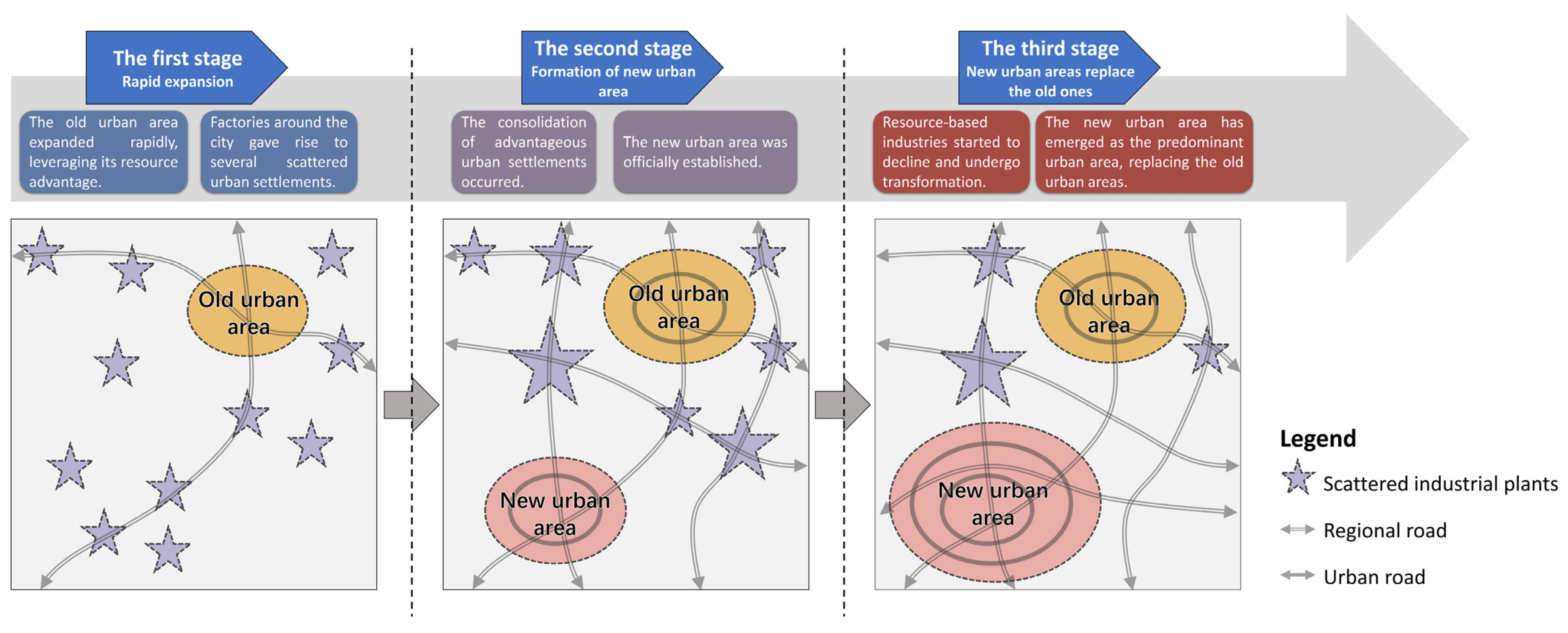






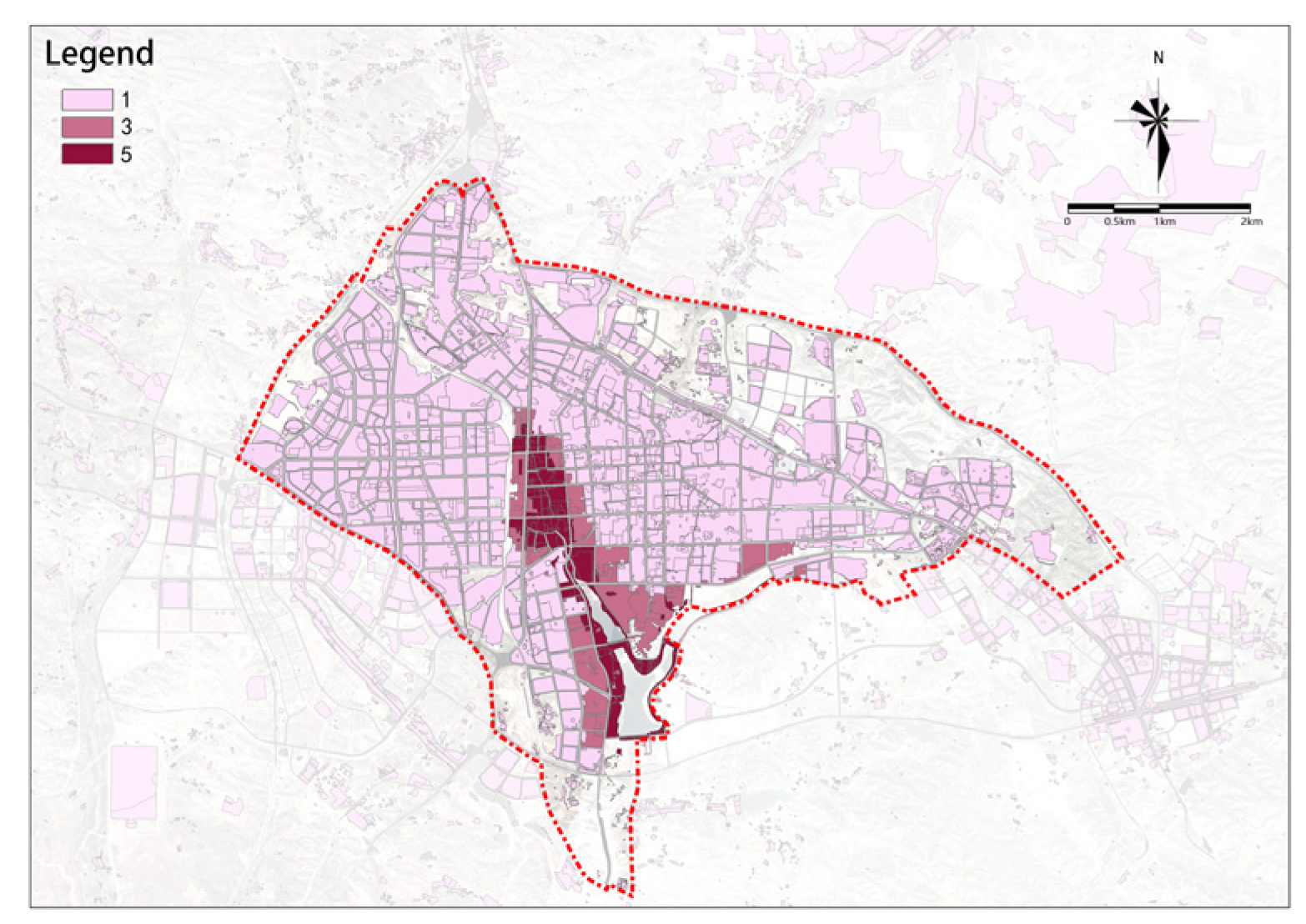

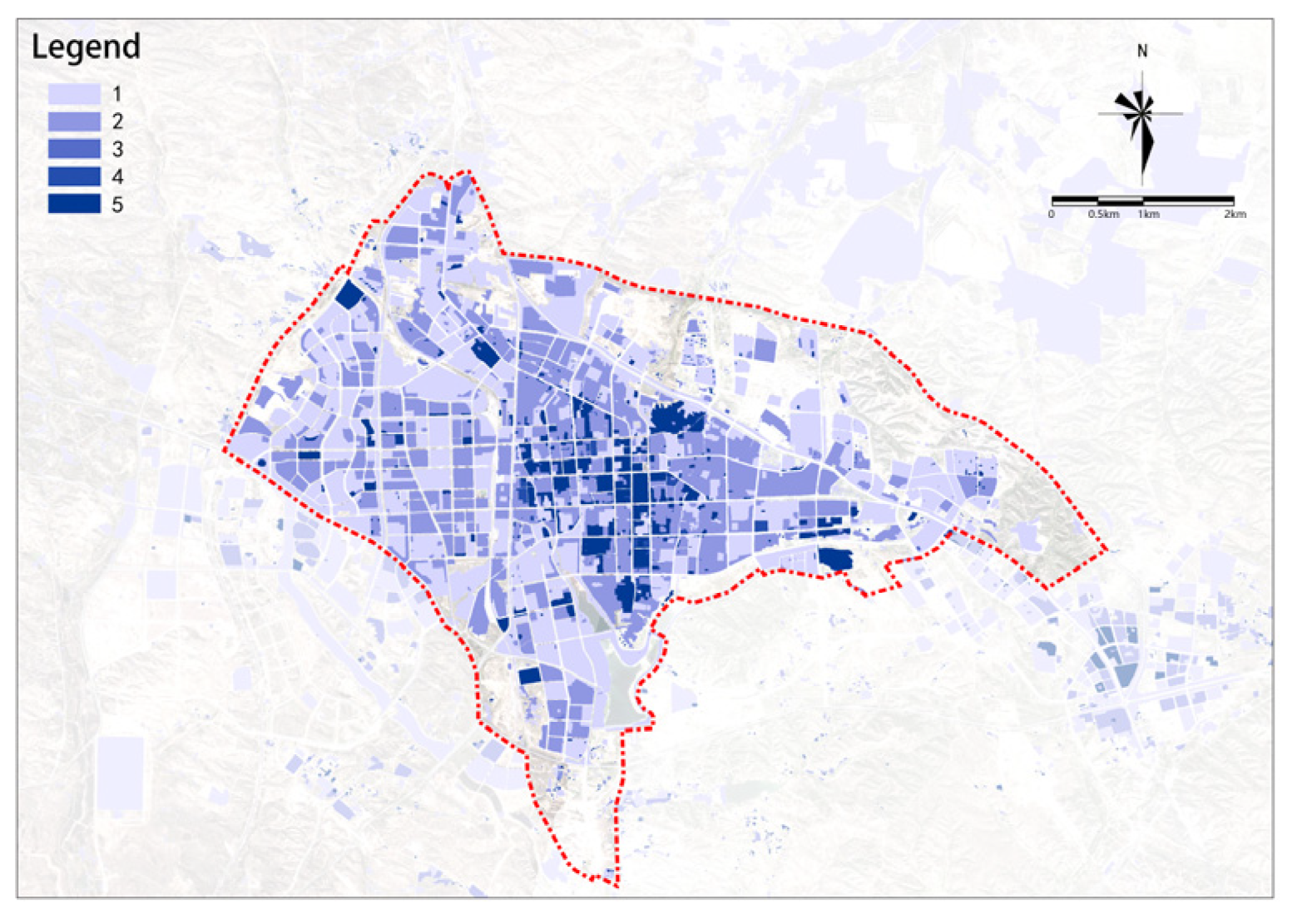


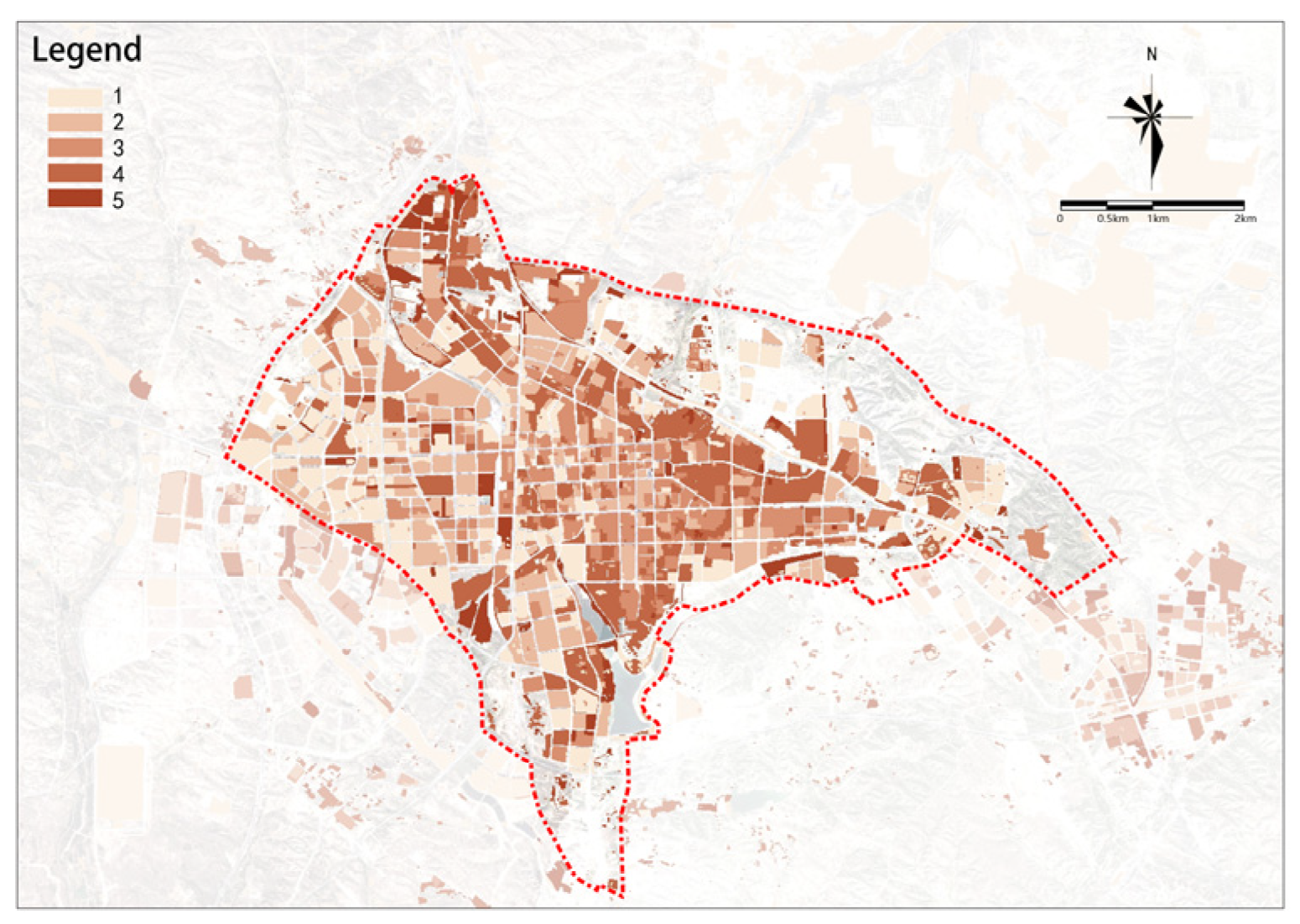
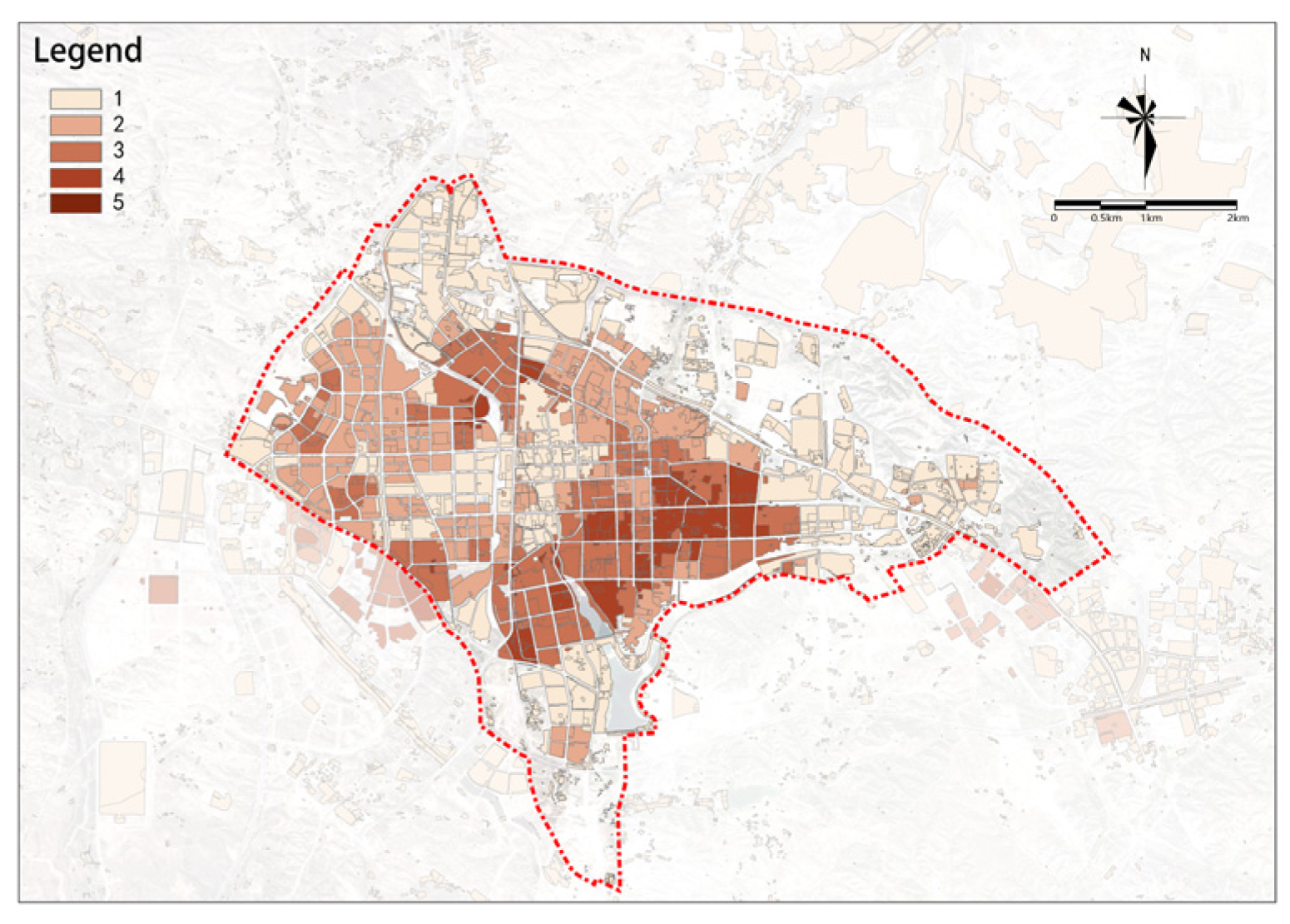


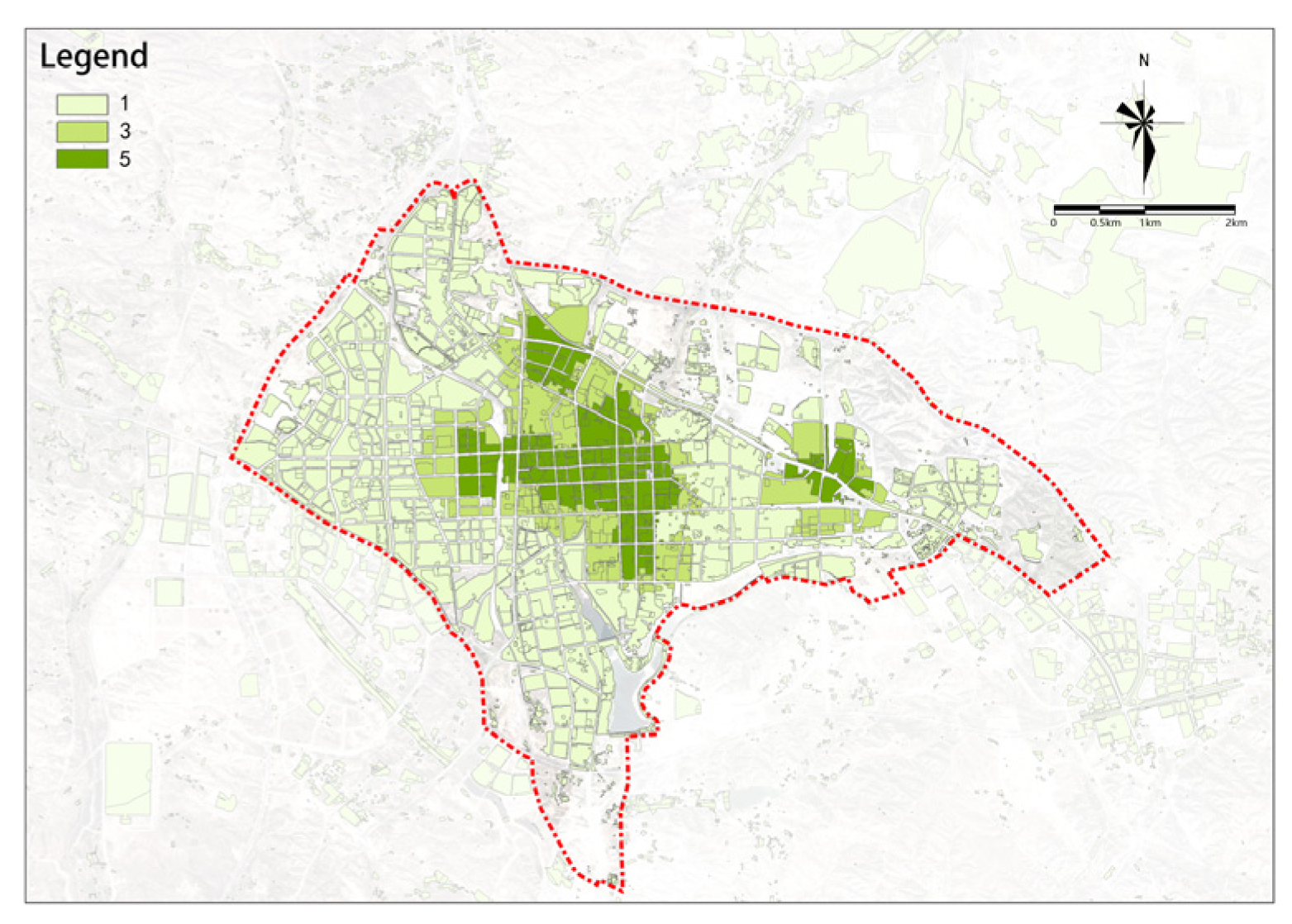





| Type | Country | City | Urban Area Structure | Leading Industries |
|---|---|---|---|---|
| Developed country | Britain | Aberdeen | Monolithic and aggregated | Energy, life sciences, food and drink, technology and digital |
| USA | Pittsburgh | Overall gathered, scattered around urban clusters | Advanced manufacturing, climate tech and decarbonization, cybersecurity, energy, life sciences and healthcare, robotics and AI, space | |
| Canada | Calgary | Monolithic and aggregated | Aerospace, agribusiness, creative industries, energy and environment, financial services, digital media and entertainment, life sciences, technology, transportation and logistics | |
| USA | Houston | Overall gathered, radiating from the center outward into a distribution of urban clusters | Business services, technology, aerospace, medicine, manufacturing | |
| Developing country | Russia | Kursk | Two urban regions formed in the north and south, relatively independent of each other | Iron and steel, electric power, machine manufacturing, metalworking, food processing |
| Azerbaijan | Baku | Scattered around urban clusters | Oil and gas extraction, shipbuilding, steelmaking, mechanical engineering, chemical manufacturing | |
| China | Daqing | Two urban regions formed in the east and west, with the middle separated by non-urban areas, relatively independent of each other | Mining, manufacturing, power, construction |
| Indicator | Top Three Types by Proportion | Proportion of Urban Villages | |||||
|---|---|---|---|---|---|---|---|
| Type | Proportion | Type | Proportion | Type | Proportion | ||
| Road connectivity | Residential | 46.96% | Commercial service | 21.88% | Green and open space | 13.34% | 9.77% |
| Population aggregation | Residential | 64.99% | Commercial service | 10.55% | Industrial and mining | 9.27% | 2.65% |
| Landscape environment | Residential | 39.07% | Green and open space | 31.25% | Commercial service | 18.11% | 8.32% |
| Floor area ratio | Residential | 49.74% | Commercial service | 14.11% | Green and open space | 13.35% | 4.56% |
| Building density | Residential | 49.08% | Commercial service | 41.52% | Public administration and public service | 4.64% | 6.30% |
| Building function | Residential | 92.82% | Industrial and mining | 7.18% | —— | —— | 4.87% |
| Building height | Residential | 42.03% | Commercial service | 14.86% | Green and open space | 14.32% | 9.12% |
| Building quality | Residential | 48.51% | Green and open space | 15.04% | Commercial service | 14.42% | 5.48% |
| Educational facilities | Residential | 60.05% | Commercial service | 15.07% | Public administration and public service | 11.62% | 7.16% |
| Medical facilities | Residential | 50.36% | Commercial service | 21.27% | Public administration and public service | 14.10% | 4.94% |
| Elder care facilities | Residential | 52.73% | Public administration and public service | 19.24% | Commercial service | 16.34% | 7.54% |
| Commercial facilities | Residential | 54.26% | Commercial service | 28.25% | Public administration and public service | 7.43% | 9.84% |
| Parks and green spaces | Residential | 45.27% | Commercial service | 19.17% | Green and open space | 17.06% | 3.22% |
| Sports facilities | Residential | 48.07% | Public administration and public service | 17.53% | Commercial service | 15.16% | 6.79% |
| Property rights complexity | Commercial service | 31.51% | Green and open space | 19.76% | Residential | 14.93% | 8.57% |
| Willingness for urban renewal | Residential | 64.99% | Commercial service | 10.55% | Industrial and mining | 9.27% | 1.22% |
| Overall assessment of urban renewal potential | Residential | 51.86% | Commercial service | 22.50% | Public administration and public service | 15.14% | 8.69% |
| Indicator | Score |
|---|---|
| Road connectivity | 3.22 |
| Population aggregation | 2.22 |
| Landscape environment | 2.95 |
| Floor area ratio | 3.34 |
| Building density | 2.55 |
| Building function | 3.18 |
| Building height | 3.33 |
| Building quality | 3.35 |
| Educational facilities | 2.55 |
| Medical facilities | 2.48 |
| Elder care facilities | 2.84 |
| Commercial facilities | 2.39 |
| Parks and green spaces | 3.31 |
| Sports facilities | 3.18 |
| Property rights complexity | 3.36 |
| Willingness for urban renewal | 2.22 |
| Overall Assessment of Urban Renewal Potential | 1.89 |
Disclaimer/Publisher’s Note: The statements, opinions and data contained in all publications are solely those of the individual author(s) and contributor(s) and not of MDPI and/or the editor(s). MDPI and/or the editor(s) disclaim responsibility for any injury to people or property resulting from any ideas, methods, instructions or products referred to in the content. |
© 2024 by the authors. Licensee MDPI, Basel, Switzerland. This article is an open access article distributed under the terms and conditions of the Creative Commons Attribution (CC BY) license (https://creativecommons.org/licenses/by/4.0/).
Share and Cite
Li, Y.; Chen, X.; Wan, J.; Liu, H.; Cui, W.; Wang, Q. Urban Renewal Potential of Old Urban Areas in Resource-Based Cities in Developing Countries: A Case Study of Dongsheng District, Ordos, China. Buildings 2024, 14, 3065. https://doi.org/10.3390/buildings14103065
Li Y, Chen X, Wan J, Liu H, Cui W, Wang Q. Urban Renewal Potential of Old Urban Areas in Resource-Based Cities in Developing Countries: A Case Study of Dongsheng District, Ordos, China. Buildings. 2024; 14(10):3065. https://doi.org/10.3390/buildings14103065
Chicago/Turabian StyleLi, Yifan, Xushen Chen, Junzhe Wan, Huiming Liu, Wei Cui, and Qianqian Wang. 2024. "Urban Renewal Potential of Old Urban Areas in Resource-Based Cities in Developing Countries: A Case Study of Dongsheng District, Ordos, China" Buildings 14, no. 10: 3065. https://doi.org/10.3390/buildings14103065






